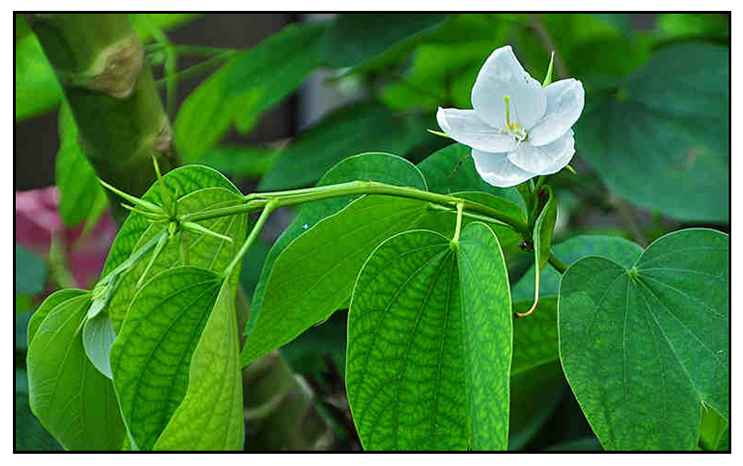| 
Botany
Bambang is a shrub growing to a height of 3 to 4 meters. Leaves are bilobed, 8 to 15 centimeters long and broad, deeply cleft from the tip to about one third of the length of the leaf. Base is somewhat cordate and the lobes are acute. Petioled is 1.5 to 4 centimeters long. Flowers are fragrant, showy and white, about 8 centimeters across; yellow-tipped stamens are ten. Pods are flat, up to 8 to 15 centimeters long and 1.8 centimeters broad.
Distribution
- Ornamental cultivation.
- Grown as hedge plant.
- Occurs in India, China to the Malay Peninsula.
Constituents
- Phytochemical screening of leaves yielded starch, alkaloids, flavonoids, tannins, reducing sugars, amino acids, and lignins. (6)
- Hydrodistillation of fresh leaves of B. acuminata for essential oil yielded nineteen compounds comprising 89.9% of leaf oil. Major constituents were phytol (65.90%), sesquiterpenoids ß-caryophyllene (13.87%) and caryophyllene oxide (3.15%).
(7)
- Preliminary phytochemical screening of leaves yielded glycoside, steroid, and flavonoids, with absence of alkaloids and tannins. Paper chromatography yielded kaempferol, quercetin, and apigenin, along with derivatives of quercetin i.e., quercetin-3-glucoside. (16)
Properties
- Studies have shown thrombolytic, cytotoxic, antidiarrheal, antibacterial properties.
Parts utilized
- Leaves, bark, roots, flowers.
Uses
Folkloric
- No reported medicinal use
in the Philippines.
- In India, decoction of bark and leaves used for biliousness and asthma. In Malaysia and Indonesia, used for cough and the common cold.
(2)
- In India, bark and leaves used in treatment of bladder stones, venereal disease, and leprosy. Paste of leaves applied locally to treat skin diseases. Roots boiled in oil applied to burns. (2)
Studies
• Cytotoxic / Thrombolytic / Leaves: Study evaluated the cytotoxic and thrombolytic activity of a methanolic extract of leaves of B. acuminata. The extract showed remarkable cytotoxic activity in brine shrimp lethality bioassay, comparable to vincristin sulphate. It showed significant thrombolytic effect using streptokinase as standard. (4)
• Antidiarrheal / Leaves: Study evaluated methanolic extracts of B. acuminata for antidiarrheal and antimicrobial activity. A crude methanolic extract showed significant antidiarrheal activity with significant reduction in magnesium induced enteropooling and dose dependent effect in castor oil induced diarrhea. Study failed to show any antimicrobial activity. (5)
• Antibacterial / Seed: Crude extract from seed kernels of Bauhinia acuminata showed strong antibacterial activity against various pathogenic gram-positive and gram-negative bacteria; the most sensitive, Bacillus subtilis and the least sensitive, Pseudomonas aeruginosa. (8)
• Membrane-Stabilizing Activity / Leaves: Study evaluated methanol extracts and fractions of leaves of B. acuminata for antimicrobial screening and membrane stabilizing activity. Results showed highly effective membrane stabilizing activity as evidenced by prevention of lysis of erythrocyte by heat and hypotonic solution. In this study, the antimicrobial activity was negligible. (9)
• Silver Nanoparticles / Comparative Biologic Activity with Leaf Extracts: Study reported on the synthesis of silver nanoparticles from leaf extracts of Bauhinia acuminata and Biophytum sensitivum. GC-MS analysis pf AgNPs showed presence of bioactive compounds like DL-alpha-tocopherol and Alphal-tocopherol-beta-D-mannose. Phytochemical analysis of the extracts showed the presence of carbohydrates, phenols, flavonoids, saponins, tannins, and triterpenoids. The methanol extract of B. acuminata showed high DPPH scavenging activity of 80% compared to that of the silver nanoparticle. Percentage hemolysis of all extracts were 6%-39%. Antimicrobial testing of the leaf extracts showed excellent activity towards B. cereus and L. monocytogenes. Study showed the plant extracts can be used as potent therapeutics than silver nanoparticles. (10)
• Anthelmintic Activity / Housefly Worms / Leaves: Study evaluated the anthelmintic activity of aqueous and ethanolic extracts of various concentrations of B. acuminata leaf extracts against housefly worms. Phytochemical screening yielded tannins and saponins in both extracts. Results showed significant dose dependent anthelmintic activity by measures of paralysis and death. The ethanol extract showed higher activity than the aqueous extract. (11)
• Nanoparticles / Antimicrobial / Larvicidal / Leaves: Study evaluated silver nanoparticles fabricated with Bauhinia acuminata leaf extract. The inexpensive aqueous extract was used as capping and reducing agent. The AgNPs showed high antimicrobial activity. Larvicidal activity against malaria, Zika virus, and filariasis vectors was reported. Results suggested the B. acuminata synthesized AgNPs have promising potential in antimicrobial food packaging as well as foliar spray to control plant pathogens, and to synergize the efficacy of fungicidal and larvicidal formulations. (12)
• Antinociceptive / Acute Toxicity Study / Leaves: Study evaluated aqueous and alcoholic leaf extracts for acute toxicity and in experimentally induced pain in animals. Acute toxicity study by OECD guideline 423 showed both extracts were safe at dose of 5000 mg/k. In hot plate test, both extracts showed significantly (p<0.001) antinociceptive activity. In hot plate test, both extracts significant reduced (p<0.001) the number of writhes. In tail immersion test, both extracts showed significant increase in tail withdrawal response (p<0.001). (13)
• Antioxidant / Leaves: Study evaluated methanol extract of leaves and various fractions of B. acuminata for biologic screening, total phenolic content and antioxidant activity. Total phenol content ranged from 15/90 mg of GAE/g extractives to 124.80 mg GAE/gm of extractives. The aqueous extract showed highest phenolic content. Antioxidant activity of IC50s in DPPH method ranged from 22.01 to 77.79. Of the extractives, carbon tetrachloride showed highest free radical scavenging activity. (14)
• Ameliorative Effect in Chronic Arsenicosis / Stem Bark: Study evaluated the ameliorative effect of B. acuminata stem bark powder against sodium arsenite (NaAsO2) induced toxicity in adult albino rats. Treatment with stem bark powder significantly )p<0.06) reduced arsenic accumulation in tissues, hair, and faeces.
Results showed oral treatment with B. acuminata stem bark powder could ameliorate induced arsenicosis. (15)
• Hepatoprotective / Carbon Tetrachloride Induced Toxicity: Study evaluated the hepatoprotective activity of B. acuminata against carbon tetrachloride induced hepatotoxicity. Hepatic damage was induced by CCl4 in combination with olive oil (1:1) in a single dose. Results showed hepatoprotective activity as evidenced by lowering of CCl3-induced elevations of SGOT, SGPT, ALP, and bilirubin levels (p<0.01), along with confirmatory histopathological examination of liver tissues. (17)
Availability
- Ornamental cultivation.
|





